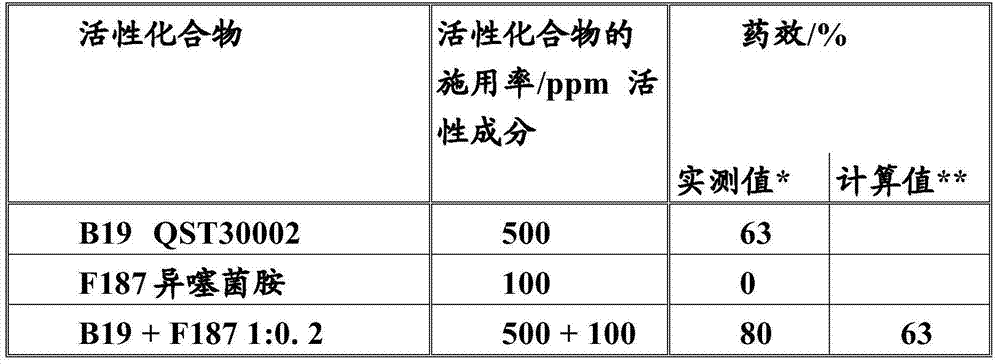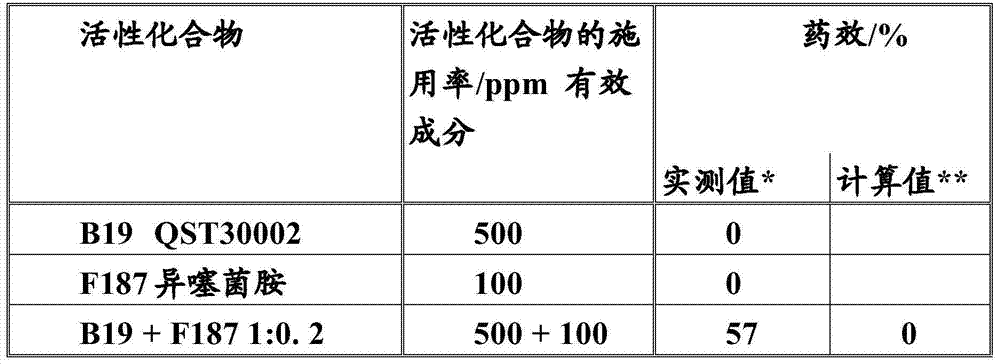Composition comprising a biological control agent and a fungicide
A technology of biocontrol agents, fungicides, applied to mites, nematodes and/or active metabolites of phytopathogens, reducing overall damage to plants and plant parts, exhibiting resistance to insects in the field, able to solve problems such as forecasting
- Summary
- Abstract
- Description
- Claims
- Application Information
AI Technical Summary
Problems solved by technology
Method used
Image
Examples
Embodiment
[0348] The good fungicidal activity of the active compound combinations according to the invention can be seen from the following examples. Although the individual active compounds exhibit weak fungicidal activity, the combinations have an activity which exceeds the simple summation of activity.
[0349] A synergistic effect of the fungicides is always present when the fungicidal activity of the active compound combination exceeds the sum of the activities of the active compounds when applied individually. The expected activity of a given combination of two active compounds can be calculated (according to Colby's formula) as follows (cf. S.R. Colby, "Calculation of the synergistic and antagonistic responses of herbicide combinations", Weeds 1967, 15, pp. 20-22):
[0350] if
[0351] X is the drug effect when active compound A is applied at an application rate of m ppm (or g / ha),
[0352] Y is the drug effect when active compound B is applied at an application rate of m ppm (...
Embodiment A
[0362] Venturia test (apple) / preventive
[0363] Dissolve QST30002 (B19), active compound (1 part by weight) or its combination in acetone / dimethylacetamide (24.5 / 24.5 parts by weight) and alkylaryl polyglycol ether (1 part by weight) with water Dilute to desired concentration.
[0364] The application rate of QST30002 refers to the amount of dried Bacillus subtilis AQ30002 (also known as QST300202) (NRRL accession number B-50421).
[0365] To test for preventive activity, young plants are sprayed with the preparation of active compound at the stated application rate. After the spray coating has dried on, the plants are inoculated with an aqueous spore suspension of the pathogenic fungus Venturia inaequalis and are then kept for one day in an incubation chamber at approximately 20° C. and a relative atmospheric humidity of 100%.
[0366] The plants are then placed in a greenhouse at approximately 21° C. and a relative atmospheric humidity of approximately 90%.
[0367] Th...
Embodiment B
[0375] Powdery mildew (Sphaerotheca) test (cucumber) / preventive
[0376] Dissolve QST30002 (B19), active compound (1 part by weight) or its combination in acetone / dimethylacetamide (24.5 / 24.5 parts by weight) and alkylaryl polyglycol ether (1 part by weight) with water Dilute to desired concentration.
[0377] The application rate of QST30002 refers to the amount of dried Bacillus subtilis AQ30002 (also known as QST300202) (NRRL accession number B-50421).
[0378] To test for preventive activity, young plants are sprayed with the preparation of active compound at the stated application rate. After the spray coating has dried on, the plants are inoculated with an aqueous spore suspension of powdery mildew fungus. The plants are then placed in a greenhouse at approximately 23° C. and a relative atmospheric humidity of approximately 70%.
[0379] The test was evaluated 7 days after inoculation. 0% means an effect corresponding to the untreated control, while an effect of 10...
PUM
 Login to View More
Login to View More Abstract
Description
Claims
Application Information
 Login to View More
Login to View More - R&D
- Intellectual Property
- Life Sciences
- Materials
- Tech Scout
- Unparalleled Data Quality
- Higher Quality Content
- 60% Fewer Hallucinations
Browse by: Latest US Patents, China's latest patents, Technical Efficacy Thesaurus, Application Domain, Technology Topic, Popular Technical Reports.
© 2025 PatSnap. All rights reserved.Legal|Privacy policy|Modern Slavery Act Transparency Statement|Sitemap|About US| Contact US: help@patsnap.com



